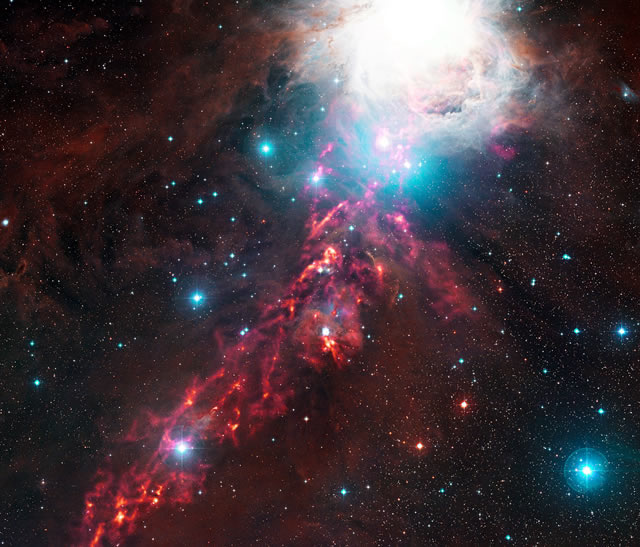
Questa nuova, straordinaria immagine di nubi cosmiche nella costellazione di Orione rivela quello che sembra un nastro infuocato in cielo. Il bagliore arancione è dovuto alla debole luce dei grani di polvere interestellare fredda, a lunghezze d’onda troppo lunghe per essere viste dall’occhio umano. È stato osservato dal telescopio APEX (Atacama Pathfinder Experiment) gestito dall’ESO in Cile.
Le nubi di gas e polvere interstellare sono la materia prima da cui si formano le stelle. Ma questi minuscoli grani di polvere bloccano la nostra visuale su ciò che si trova all’interno e dietro alle nubi – almeno alle lunghezze d’onda del visibile – rendendo difficile osservare il processo di formazione stellare. Questo è il motivo per cui gli astronomi devono usare strumenti in grado di vedere luce di altre lunghezze d’onda. Nella banda submillimetrica i grani di polvere non bloccano la luce ma risplendono a causa della loro temperatura di qualche decina di gradi sopra lo zero assoluto [1]. Il telescopio APEX, con la sua camera LABOCA per lunghezze d’onda submillimetriche, e l’altitudine di 5000 metri sul livello del mare nella piana di Chajnantor nelle Ande cilene, è lo strumento ideale per questo tipo di osservazioni. Questa nuova, spettacolare fotografia mostra parte di un complesso più grande noto come Nube Molecolare di Orione, nella costellazione omonima. Un crogiuolo di nebulose brillanti, di stelle giovani e calde e di nubi molecolari fredde: questa regione si estende per centinaia di anni luce e si trova a circa 1350 anni luce da noi. Il bagliore prodotto dalle nubi di polvere fredda a lunghezze d’onda submillimetriche è di color arancio in questa immagine, ed è sovrapposto a una fotografia presa nella più familliare luce visibile. La grande nube brillante in alto a destra nell’immagine è la ben nota Nebulosa di Orione, chiamata anche Messier 42. È facilmente visibile a occhio nudo come la “stella” leggermente sfuocata nel centro della spada di Orione. La Nebulosa di Orione è la zona più brillante di un’enorme incubatrice stellare in cui nascono nuove stelle ed è il sito di massiccia formazione di stelle più vicino alla Terra.
Fonte/Leggi tutto → ESO.org
This dramatic new image of cosmic clouds in the constellation of Orion reveals what seems to be a fiery ribbon in the sky. This orange glow represents faint light coming from grains of cold interstellar dust, at wavelengths too long for human eyes to see. It was observed by the ESO-operated Atacama Pathfinder Experiment (APEX) in Chile.
Clouds of gas and interstellar dust are the raw materials from which stars are made. But these tiny dust grains block our view of what lies within and behind the clouds — at least at visible wavelengths — making it difficult to observe the processes of star formation. This is why astronomers need to use instruments that are able to see at other wavelengths of light. At submillimetre wavelengths, rather than blocking light, the dust grains shine due to their temperatures of a few tens of degrees above absolute zero [1]. The APEX telescope with its submillimetre-wavelength camera LABOCA, located at an altitude of 5000 metres above sea level on the Chajnantor Plateau in the Chilean Andes, is the ideal tool for this kind of observation. This spectacular new picture shows just a part of a bigger complex called the Orion Molecular Cloud, in the constellation of Orion (The Hunter). A rich melting pot of bright nebulae, hot young stars and cold dust clouds, this region is hundreds of light-years across and located about 1350 light-years from us. The submillimetre-wavelength glow arising from the cold dust clouds is seen in orange in this image and is overlaid on a view of the region taken in the more familiar visible light. The large bright cloud in the upper right of the image is the well-known Orion Nebula, also called Messier 42. It is readily visible to the naked eye as the slightly fuzzy middle “star” in the sword of Orion. The Orion Nebula is the brightest part of a huge stellar nursery where new stars are being born, and is the closest site of massive star formation to Earth.
Source/Continue reading → ESO.org

















